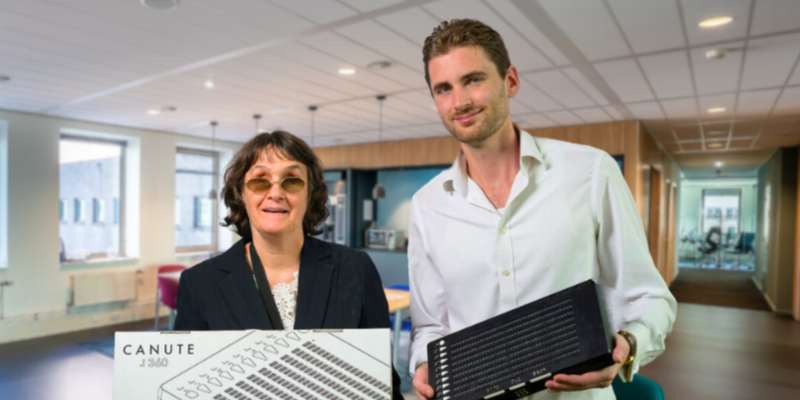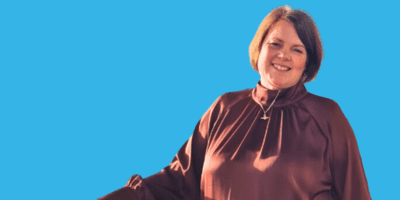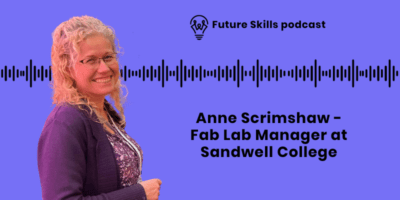Steph Sergeant recently became one of the directors of Bristol Braille, a UK-based technology company that developed the world’s first multi-line Braille e-reader, called Canute. She is known for her dedication to making technology more accessible for blind visually impaired individuals. Since 2017, Steph has been working alongside Bristol Braille founder, Ed Rogers, and has been instrumental in the development and success of the Canute, a revolutionary device that has transformed the way visually impaired people read and interact with digital text.
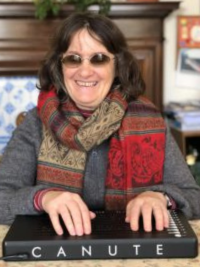
“Blind pupils are leaving school using audio only or large print rather than Braille. Braille is getting harder to come by and large print is even more difficult because it’s even bulkier so if a child can’t see to read ordinary-sized print they really need to be able to read Braille in order to communicate properly.”
It’s not what you say that counts, it’s the fact that you’re doing it
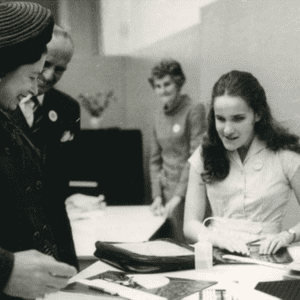
I’m blind and I went to a school that no longer exists. They did everything they could to give us a really good education, which meant I was able to go to university to get a psychology degree. I was the second blind woman in the country to get one as it wasn’t quite so common in those days.
I then tried to get a job in psychology but I couldn’t find one. I worked in a prison for a while on a student work placement and then I switched to computer programming. I needed to use various machines, including an Opticon, which translated print into a tiny raised letter.
I also had a Braille display but that only displayed one line at a time so it was very limiting. I must have found various ways of getting around it, because I discovered, to my surprise, that when I was off sick with a repetitive strain injury my company had to employ two sighted people to replace me and they still finished a month behind the deadline that I’d been given. I think I was as shocked as they were, but it just shows that, given the opportunity, blind people can do things the same as sighted people.
At work, I was then asked to help a gentleman who had sadly gone blind overnight. He was managing a team of database designers and he came to see all my specialist equipment. At the end of the hour, he said: “It’s not what you’re saying that counts, it’s the fact that you’re doing it.”
That gave me the idea that I could be useful to other blind people, rather than just lining the pockets of the managers who earned far more than I did in computing. So, I trained as a rehab worker for newly blinded adults and then I worked on user participation for Action for Blind People finding out what the customers really want and making sure that happens.
A new type of multi-line Braille display
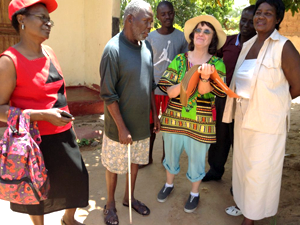
I’ve been running my own company, Vision Through Sound, since 2017. I work on many diverse projects, including supporting a school for the blind in Zambia to enable them to have one piece of writing equipment for every pupil rather than sharing one between two, for instance. That’s how I found I had a shared interest with Ed Rogers, founder of Bristol Braille, so I joined as a director.
Both my company and Bristol Braille are CICs — community interest companies — so all the work we do is driven by purpose rather than profit. I find it thrilling to be able to go out to the blind and partially-sighted community, find out what they want and then feed this back into the process of developing new innovations that make a real difference to lives.
Introducing the Canute
Braille works by using one more of six dots, similar to the dots on a domino, to form each letter. Braille uses those combinations of dots to form different letters and also lots of different signs and shorthand. Existing Braille readers only have 20 characters, so imagine trying to read your Kindle or phone, or work your computer when the amount of data you could access at any one time was only about the size of a calculator screen. They could only access a few characters in one go and you have to move the cursor along to make it display the next chunk of information.
With the Braille display that Bristol Braille is developing though, called ‘Canute’, there are nine lines by 40 cells, so it’s equivalent to being able to read a third of a page of a book instead of just a few characters at a time, which, as you might imagine, makes a much more pleasurable reading experience.
An innovative piece of kit
The Canute is a very innovative piece of kit, conceptualised back in 2011 when Ed saw some Braille software that had been developed to help blind children in India learn to read, and he discovered that Braille is incredibly important for literacy.
We estimate that about 80% of blind people who are employed are Braille readers because if you can read it obviously makes work a lot easier, but many blind people need to rely on speech output only in order to do their work. The problem is exacerbated by the fact that currently, Braille is very bulky (20 times the size of print) and also very expensive (ten times the cost of print).
Using the Canute, I’ve got 6,000 books stored on one SD card now, just as sighted people store books on Kindles. There was one deaf-blind customer who had floor-to-ceiling Braille books in his front room before getting a Canute because deaf-blind people can’t use audio, but now he’s got a Canute and he’s been able to copy thousands of books onto one SD card, so it’s just transforming people’s lives.
The device was named after King Canute who told the waves to go back. We’re hoping that the Canute will cause a reverse in the downward trend of Braille, and that’s already starting to come about. It’s incredibly exciting because we’ve now got 700 Braillists in a community group of blind people who are championing Braille.
During lockdown, we trained 115 people to read basic Braille and that gave them the motivation and the peer support to carry on learning the full version of Braille. We’re also supporting blind people around the world using Canute.
By Braillists for Braillists
The development process for the Canute has been very different from what happens normally when manufacturers produce a new product and bring it to the market and they make it perfect before they sell it to the customers. This does have its advantages but what Ed wanted to do with Bristol Braille was create affordable prototypes so that they could get loads of feedback from the community as to what people really want, so that the design is all done by Braillists for Braillists.
That meant taking different prototypes anywhere blind people could get a feel for them, in the UK and beyond. I took devices to various places in Scotland with a very good friend of mine, including The Royal Blind School in Edinburgh and Glasgow Library. We’ve also travelled around locations in Wales. We’re in close contact with Child Vision in Dublin too. They have provided loads of input and finance for the Canute.
We’ve also been to America several times, including attending the National Federation of the Blind Convention. They bring together 3,000 blind people each year, so we’ve been to events in Las Vegas, Florida and Houston, Texas.
The Canadian Institute for the Blind has also had input, as well as organisations in New Zealand, and Australia. We’ve got a lovely quote from Australia:
“I was sick and tired of pressing a button to read every few characters. It’s a real treat to be able to read nine lines of Braille with 40 cells on each line.”
There’s a universal standard called English Braille that works for all English-speaking languages, but then each language has its own Braille character set too. So, for example, I come across character sets in German, Gujarati and Farsi too.
We’ve sold two or three Canutes to Uzbekistan and there is the potential for it to be used all around the world in different character sets.
Transforming education and employment opportunities for blind and visually impaired people
Blind pupils are leaving school using audio only or large print rather than Braille. Braille is getting harder to come by and large print is even more difficult because it’s even bulkier so if a child can’t see to read ordinary-sized print they really need to be able to read Braille in order to communicate properly.
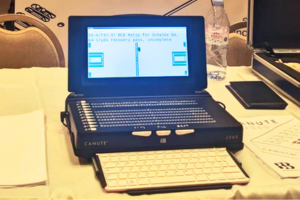
Using adapted icons on the Braille display we can create graphs, diagrams, symbols and pictures so you can get a visual image into your brain from 2D Braille, so imagine the difference that can make in education. We’ve produced a diagram of a digestive tract and a transverse picture of a cell of a leaf, and all kinds of things like that.
We’ve downloaded open-source software from Google Maps and converted it into street maps for the town centre of Bristol. We’ve also produced maps of the world. We’ve even worked with NASA as you don’t need to be able to see to discover new planets and stars these days as you do it all by calculation, so we’ll be able to help with that by using a two-dimensional display of Braille.
From an employment perspective, Ed recently met a Canute user who had recently gone blind. His career had been in statistical analysis and data. He’d bought loads of data and he had been testing it out on all the different Braille machines that are currently available. He chose a Canute because it performed best and was the easiest to use.
We have a woman who has two Canutes. She’s using one to learn the Cornish language and the other at work for coding. As it’s Linux-based, the Canute lends itself perfectly to computer science students who want to learn coding. Given the massive skills shortage in computing there’s a huge opportunity here.
We’ve also got a user to works in computer-aided design and we’re exploring how it can be developed to support him with his work too.
As we continue to develop Canute, we’re able to adapt the scripting so it can be personalised for different uses.
How the Womanthology community can support
As I mentioned earlier, Bristol Braille is a community interest company. We’ve been able to do all this research and development by bidding for grants, loans and investments.
For the last two years, we have been developing the Canute Console. It is a Linux workstation with a multiline Braille display. It is composed of a Canute 360 Braille display docked in a workstation that adds a pull-out Qwerty keyboard, a fold-up 13″ high contrast monitor, and runs off a Raspberry Pi 400. This means the Canute can be connected to the internet and becomes interactive. It allows co-working and co-playing between Braille readers and their sighted or low-vision colleagues.
We are now selling the Canute Console and we’d like to find companies that would like to buy one or two consoles. They’re now retailing for about £4,000, whereas our nearest competitors are more like £15,000, although they do something different and they work on a different basis to the Canute.
Feel free to email me at stephanie@visionthroughsound.co.uk if you’d like any more details about the Canute and ways it might be able to help blind and partially sighted people.
Coming up next
Coming up next I’m looking forward to new projects on the Canute, which will enable it to do things that we haven’t been able to before.
Outside of work, I’m a keen swimmer so I’m looking forward to doing more of that.

